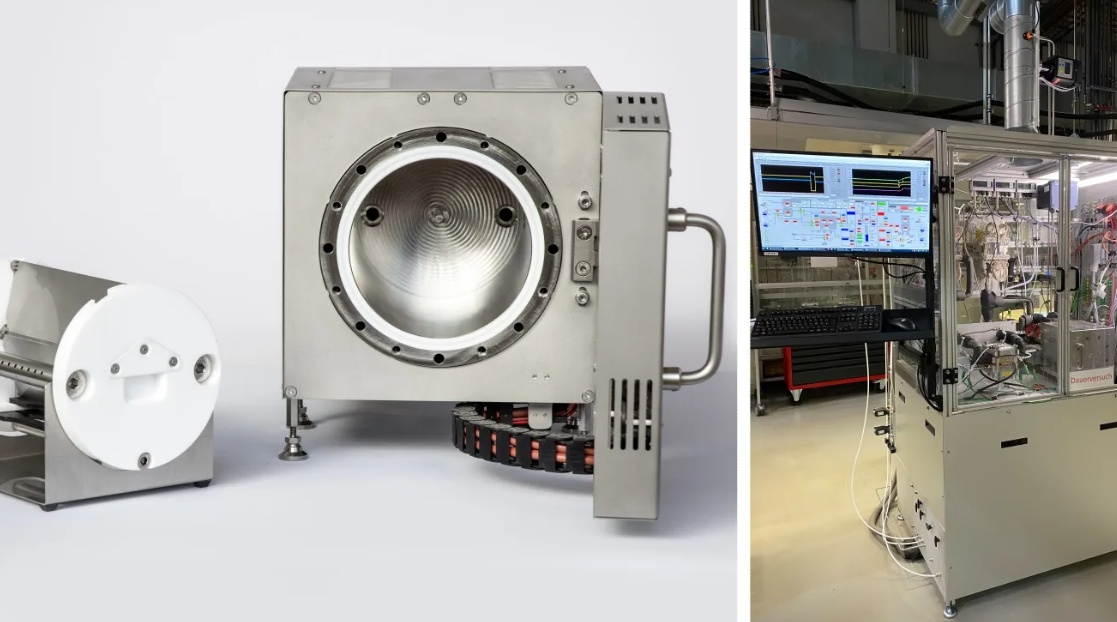SKZ and ZBT, together with industry partners, have developed evaluation methods for polymer-based materials used in fuel cell systems. This initiative aims to support the selection of suitable plastics under specific application conditions and to systematically analyze the compatibility, emissions, and long-term performance of the materials.

ZBT developed and used emission chambers for different material types projects (left) and the ZBT material identification test bench (right)
Hydrogen fuel cell systems are considered a key technological component for sustainable energy supply—whether in mobile applications such as vehicles, rail transport, or ships, or in stationary systems, such as decentralized power and thermal energy generation. The successful technological implementation and economic scaling of these systems depend on the use of suitable materials. Plastics, in particular, are used for many components, such as seals, pipes, or pumps. These materials come into direct contact with the reactive media and must therefore exhibit high chemical resistance, purity, and long-term stability. Therefore, systematically evaluating material performance under application-relevant conditions is crucial to supporting informed choices of suitable plastics.
Evoplast: Evaluation of Plastics for Fuel Cells
From May 1, 2023 to April 30, 2025, in the Evoplast industry project, the SKZ Plastics Center and the Fuel Cell Technology Center (ZBT) are focusing on material-specific assessments of plastics in the field of PEM fuel cells (proton exchange membrane fuel cells). The aim is to define application-specific standards in order to systematically support the selection of polymer-based materials with regard to media resistance, purity, and long-term behavior.
In-situ testing methods for material evaluation
As part of the project, an in-situ testing method developed by ZBT was used, and the impact of plastic materials on fuel cell behavior was further developed. This method is based on purposefully storing plastic samples under specified conditions in a test chamber that can be integrated into the cathode or anode supply lines of the fuel cell.
The emissions released from the plastic samples are introduced into a downstream fuel cell designed as a sensor cell. In this way, a direct correlation can be established between the emitted substances and their potential impact on the electrochemical performance of the fuel cell.
"Materials used in fuel cell components (such as valves, pipes, and seals) must meet the highest standards. In-situ measurement methods allow for the direct analysis and assessment of the impact of potential desorption emissions (such as volatile components in material samples) on cell performance," explained Dr. Ulrich Misz from ZBT.
Industrial Practice Test Protocol
In situ analysis was supplemented by ex situ investigations using gas chromatography (GC) and mass spectrometry (MS) to accurately identify the types and concentrations of emitted substances. During the project, specially tailored testing protocols were developed to meet the requirements of fuel cell systems and were successfully implemented for potential final applications.
"The combined method of in situ performance evaluation and off-site emission analysis can provide a comprehensive assessment of material compatibility," said Alexander Rusam, project manager and scientist for materials development and testing at SKZ.
Main Findings at a Glance
Heterogeneity of polymer emission behavior:
The survey indicates that despite the same testing conditions, the plastics used in fuel cells cause significantly different performance losses. The measured voltage loss ranges from 0% (i.e., no impact) to 50%, or even complete failure of overall performance within a few hours.
During the project, it was found that the same base materials from multiple partners provided distinctly different in-situ results. This confirmed the hypothesis that even small amounts of additives, such as fillers or stabilizers, can affect desorption behavior and lead to an increased degradation rate of the fuel cell.
Transferring research results to the industrial process chain:
Participated in systematically improving the company's material range using obtained data and adapting it for specific applications. To this end, potential emission-reducing pretreatment steps were developed and tested within the project. Pulses were provided to optimize processing parameters during the manufacturing process.
Prospect: Plans for further research
This project has laid the foundation for a deeper study of material selection and system behavior in fuel cell technology. A follow-up project within the IGF framework is currently being prepared.












